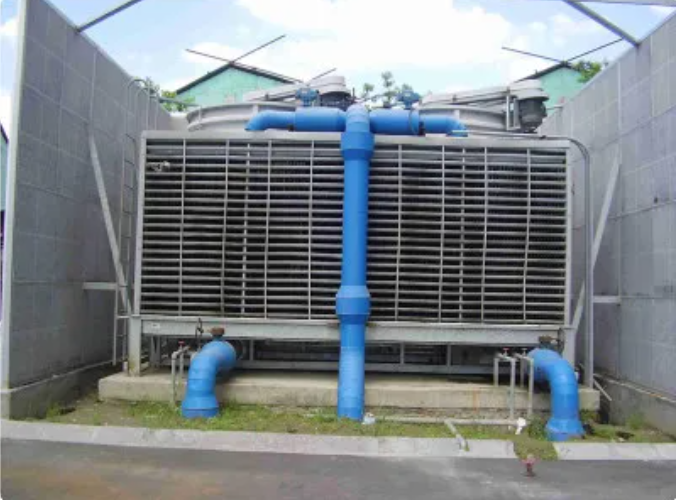
A Few Tips on Noise Reduction in Cooling Towers
2023-06-30 09:14Both natural ventilation cooling towers and mechanical ventilation cooling towers can generate noise, affect people's lives, and cause environmental pollution. So what are the factors that generate noise?
In terms of mechanical ventilation cooling towers, the main reasons for generating noise are as follows:
Aerodynamic noise
It is one of the main noise sources of mechanical ventilation cooling towers, originating from fans and consisting of rotating noise and eddy current noise. The fundamental frequency of rotating noise is directly proportional to the impeller speed and number of blades, while the fundamental frequency of eddy current noise is directly proportional to the relative velocity of airflow and blades, and inversely proportional to the thickness of the object in the direction of airflow incidence. This type of noise is characterized by frequency bandwidth and prominent mid to low frequencies, which propagate far and are not easily attenuated at low frequencies.
Watering noise
It is the main noise source of the counter current cooling tower, directly proportional to the water spray density and drop height, and also related to the ventilation speed inside the tower. It is a high intensity steady-state noise mainly at medium to high frequencies.
Mechanical noise
The vibration and noise generated by rotating machinery such as electric motors, fans, and transmission components(composite coupling、gearbox) under the periodic action of eccentric forces caused by the imbalance of the rotating system. Among them, the noise intensity of the fan is related to the fan diameter, speed, and ventilation rate. Under the same ventilation rate conditions, the larger the fan diameter, the lower the noise, which is proportional to the relative velocity of the blades and fluid.
Other noise
The secondary noise mainly generated by tower body vibration is a type of noise caused by solid component vibration caused by power equipment(composite coupling、gearbox) , which radiates outward when the vibration propagates in the wall panel.
To summarize, , reducing the noise of the cooling tower can be carried out in the following three steps.
Firstly, for mechanical ventilation cooling towers, noise source control is the first step in noise control, which can be achieved through the following aspects:
Measure 1: Reduce the overall airflow resistance of the mechanical ventilation cooling tower. According to the requirements of the process and site layout, determine the form of the cooling tower, try to increase the flow area of the airflow, and ensure that the components through which the airflow passes comply with the fluid flow characteristics to achieve the goal of reducing tower resistance.
Measure 2: Choose a low-noise fan, choose a fan blade type with anti noise design to reduce the specific noise of the fan, and choose a low-speed fan.
Measure 3: The noise of the motor mainly comes from the fan of the motor. Using a unidirectional fan can reduce the noise by 4-12dB, and a dual speed fan can also be selected. When the temperature is low at night, it can operate at low speed to reduce the noise.
Measure 4: arrange falling impact materials (noise elimination pads) in the water collecting tank of the cooling tower to reduce the noise of water droplets. Soft foamed plastics can be selected. Semi soft droplet fillers can also be arranged in the rain area of the cooling tower inlet to slow down the falling speed of water droplets and reduce noise by about 9-15dB.

Fig. 1 Damping Pad
Measure 5: For small mechanical ventilation cooling towers, vibration isolation measures can be adopted to reduce the vibration of the cooling tower body. The fan is subject to low-frequency vibration. When installed on the roof without vibration isolation measures, the vibration propagates far along the solid structure. In this case, a damping vibration isolator can be used, which can play a good role.
Secondly, when the noise source control of the cooling tower still cannot meet the requirements, silencers can be installed at the inlet and outlet of the cooling tower. After installing silencers at the outlet, the noise can be reduced by about 20dB (A), and the inlet noise is generally 10dB (A) lower than the outlet noise. Of course, the outlet of the cooling tower can also be directionally designed before installing silencers, so that the direction of noise propagation at the outlet is far away from sensitive points such as residential areas. However, silencers can increase the airflow resistance of the cooling tower, and it is necessary to carefully calculate the process conditions of the cooling tower. If necessary, the design of the cooling tower needs to be adjusted.

Fig. 2 Cooling tower with added silencer
Finally, in some special cases, such as the presence of residential areas and other noise sensitive points in multiple directions of the cooling tower, directional control can be achieved by setting soundproof panels.

Fig. 3 Cooling tower with added soundproof panels
Of course, the specific noise reduction measures to be taken depend on the on-site environment and the owner's requirements. But no matter which method is used, as long as it can effectively reduce noise and meet environmental requirements without affecting the core performance of the cooling tower, it is worth using. Do you think?

Fig. 4 Composite coupling for Cooling tower
